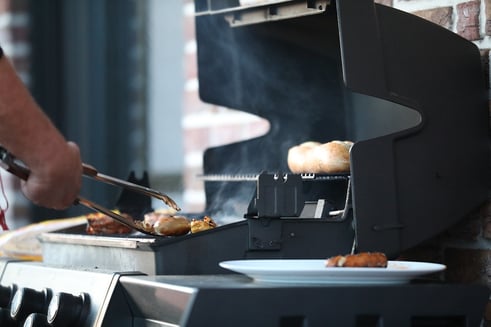 When you’re hosting a party in your outdoor kitchen, the last thing you want is for your gas grill to run out of propane halfway through cooking your steaks or while the chicken on your kebabs is still raw!
When you’re hosting a party in your outdoor kitchen, the last thing you want is for your gas grill to run out of propane halfway through cooking your steaks or while the chicken on your kebabs is still raw!
But how do you check the amount of propane left in your tank before your guests arrive? After all, propane is an invisible liquid in a heavy opaque container—it’s not like you can eyeball it.
Fortunately there are some simple methods for determining the amount of propane left in your grill tank, so you can be confident you can cook up a meal for your guests without interruption—or have enough time to get your tank refilled before your guests start arriving.
First, some figures to work with
While propane comes out of the valve as a gas when you cook (obviously), the propane in the tank is stored under sufficient pressure to be in a liquid state. That’s why we can measure it in terms of pounds and gallons. Here are some ballpark figures to base rough calculations on:
- A typical tank holds about 20 pounds of liquid propane. (That's in addition to the weight of the tank itself.)
- A gallon of propane weighs 4.2 pounds, so a typical tank holds about 4.8 gallons.
- A gallon of propane will provide about 1.5 hours of cooking time, depending on several factors.
So, 20 pounds in a tank = 4.8 gallons = about 7 hours of cooking time per tank.
Of course, some grills will give you much more cooking time than that! These figures can change based on the model of the grill you use, how hot you tend to run your grill, and even the temperature outdoors. But if you work with the 7-hour figure, you'll be less likely to run out prematurely.
Time it
Keeping these ballpark figures in mind, one way to determine how much propane you have left in your tank is to keep track of how long your cooking sessions are, and how many you've had since the tank was full. (e.g. You've used the grill once a week for a month, 30 minutes each time.)
Of course, this method requires you to have taken careful note of how often you’ve used your tank since it was refilled. The amount of propane you use per session also varies slightly depending on the heat settings, so it’s not a foolproof method.
If you’ve just been using the same tank for a couple of seasons and can’t remember the last time you refilled it, you’ll need to use another method.
Weigh it
Carefully disconnect the tank from your grill, and then step on a bathroom scale while holding the tank. Take the total weight and subtract your own weight, and then subtract the weight of the tank itself. (This number should be marked on the side with a TW for Tare Weight. If your tank doesn’t have a label, check to see if the numbers are engraved onto the metal.)
The weight that remains is the amount of propane in the tank.
Wet it
Another method is to pour a glass of warm (not hot!) water down the side of the tank, then feel for a temperature difference. Where the tank is empty, the metal will feel warm, but where the tank is full of liquid propane, the metal will stay cool. The line of cold will help you visually gauge how high or low the propane level is.
This method doesn’t give you a precise number, of course, but it can help you estimate how empty your tank is running, and whether you should get a refill before your cookout.
Gauge it
As with many things, there’s a gadget for this that can make your life easier.
Many high-quality gas grills already have a gauge built in to alert you to exactly how much gas remains in the tank. If your grill doesn’t include such a gauge, you can find and purchase them relatively easily.
Skip it
If you practically live in your outdoor kitchen and want to bypass the hassle of refilling small propane tanks altogether, you can connect your grill directly to your home’s gas supply (if you have one). This operation involves a number of important safety considerations, so be sure you know what you’re doing—or call one of our experts to help you!

